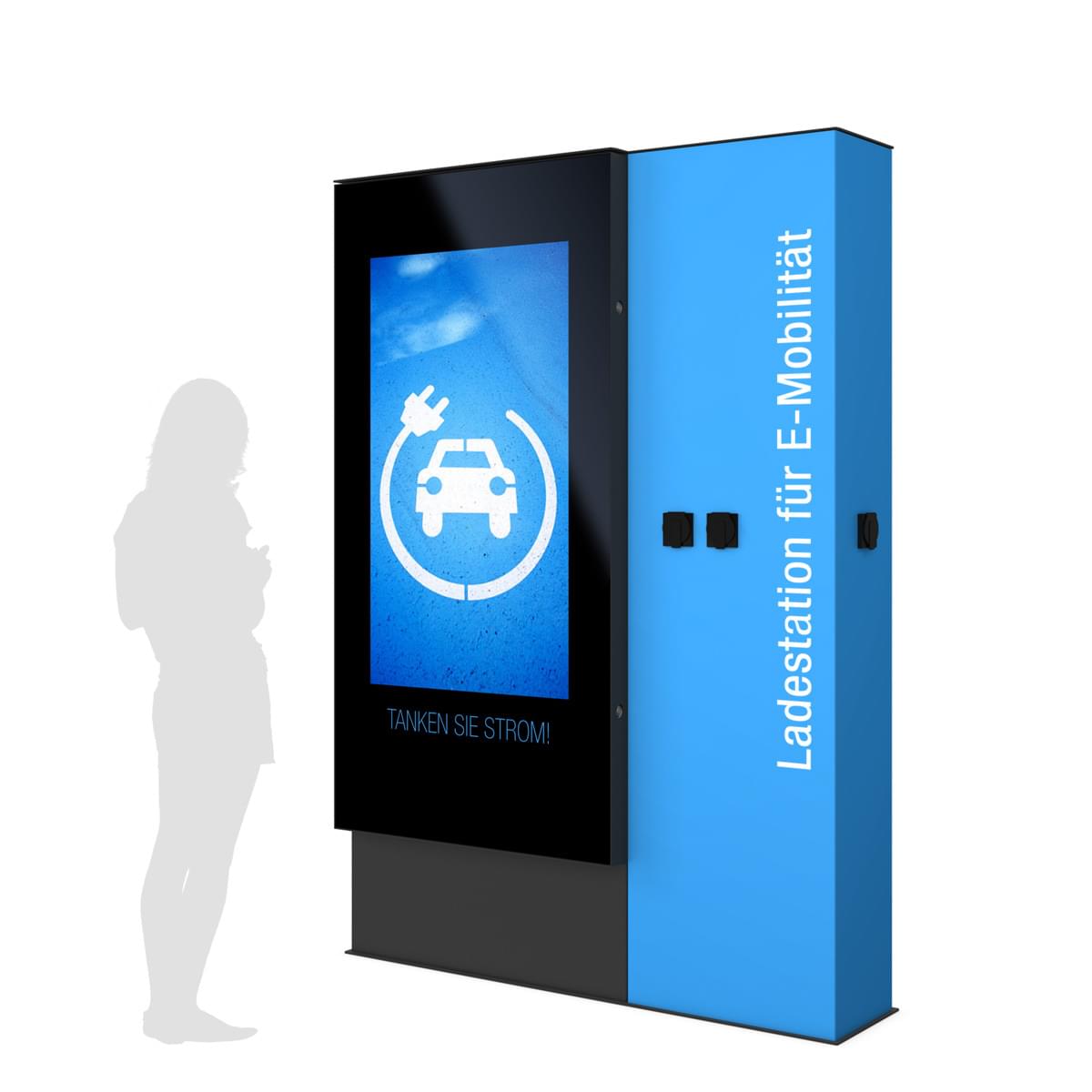Electric Vehicle Charging Stations as Outdoor Advertising Carriers
The Federal Cabinet has therefore adopted the Infrastructure Master Plan in recent days. It contains measures for the rapid development of a comprehensive and user-friendly charging infrastructure for up to ten million electric vehicles by 2030. More than three billion euros will be invested in this by 2023.
Even if the plan, which emerged from the Federal Government’s climate protection programme, mentions 2030 as the deadline, changes are to be driven forward as soon as possible. To make electric mobility more attractive, 50,000 publicly accessible charging points are to be set up over the next two years. In addition, more charging points at customer car parks will be promoted. These measures are of great importance if the goal of making traffic more climate-friendly is to be achieved. The investment in the charging infrastructure for e-cars must also be made for reasons of user-friendliness and comfort. There are still a number of adjustments to be made here, as the ADAC study on public e-car charging stations shows.
Not All Charging Stations Are The Same
The charging stations, which are already in operation, differ in many aspects. As in the real estate market, the location is one of the decisive factors. Some parking lots that have a charging station are often quite small and are too close to traffic. Obstructions to visibility at the installation site can also be disturbing.
The appearance of the charging stations also plays a role that should not be underestimated, as they often have the size and shape of power distribution boxes, making them easy to overlook. In the dark, drivers may find the columns difficult to spot, especially if they are unfamiliar with the surroundings.
The user-friendliness of charging stations often leaves a lot to be desired, even though they are usually technically ok. There is hardly any ease of use and the access systems are not uniform. Unfortunately, there is often a lack of transparency when it comes to tariffs and payment methods. At one station the driver needs a loading card, at the other the corresponding app. Electricity prices themselves fluctuate very strongly depending on the provider and the billing systems are sometimes confusing. The result: drivers lose track in jungle of charging columns.
Of course, not all charging stations perform poorly. The charging stations that were listed in all the important directories were positively outstanding. Provider-independent stations stand out due to their flexibility, because customers from different electricity providers can charge their cars at the same column. It is also advantageous if informative websites or apps are available that show whether a charging station is occupied or defective. Timely warnings save the customer time, nerves and kilometers. So that the driver does not get confused with the different tariffs and payment methods, the column or app shows the electricity price per unit.
Charging Stations Offer New Advertising Possibilities
The waiting times at an e-charging station are considerably longer than with conventional dispensers. This allows advertisers to take advantage of long recharging times. Charging stations could serve as advertising media for advertisements.
The Federal Cabinet has therefore adopted the Infrastructure Master Plan in recent days. It contains measures for the rapid development of a comprehensive and user-friendly charging infrastructure for up to ten million electric vehicles by 2030. More than three billion euros will be invested in this by 2023.
Even if the plan, which emerged from the Federal Government’s climate protection programme, mentions 2030 as the deadline, changes are to be driven forward as soon as possible. To make electric mobility more attractive, 50,000 publicly accessible charging points are to be set up over the next two years. In addition, more charging points at customer car parks will be promoted. These measures are of great importance if the goal of making traffic more climate-friendly is to be achieved. The investment in the charging infrastructure for e-cars must also be made for reasons of user-friendliness and comfort. There are still a number of adjustments to be made here, as the ADAC study on public e-car charging stations shows.
Not All Charging Stations Are The Same
The charging stations, which are already in operation, differ in many aspects. As in the real estate market, the location is one of the decisive factors. Some parking lots that have a charging station are often quite small and are too close to traffic. Obstructions to visibility at the installation site can also be disturbing.
The appearance of the charging stations also plays a role that should not be underestimated, as they often have the size and shape of power distribution boxes, making them easy to overlook. In the dark, drivers may find the columns difficult to spot, especially if they are unfamiliar with the surroundings.
The user-friendliness of charging stations often leaves a lot to be desired, even though they are usually technically ok. There is hardly any ease of use and the access systems are not uniform. Unfortunately, there is often a lack of transparency when it comes to tariffs and payment methods. At one station the driver needs a loading card, at the other the corresponding app. Electricity prices themselves fluctuate very strongly depending on the provider and the billing systems are sometimes confusing. The result: drivers lose track in jungle of charging columns.
Of course, not all charging stations perform poorly. The charging stations that were listed in all the important directories were positively outstanding. Provider-independent stations stand out due to their flexibility, because customers from different electricity providers can charge their cars at the same column. It is also advantageous if informative websites or apps are available that show whether a charging station is occupied or defective. Timely warnings save the customer time, nerves and kilometers. So that the driver does not get confused with the different tariffs and payment methods, the column or app shows the electricity price per unit.
Charging Stations Offer New Advertising Possibilities
The waiting times at an e-charging station are considerably longer than with conventional dispensers. This allows advertisers to take advantage of long recharging times. Charging stations could serve as advertising media for advertisements.

In a future scenario, a new business model is possible: Drivers are confronted with advertising during the charging process, but in return are allowed to supply their car with electricity free of charge.
So that the charging station is not confused with a mere digital signage installation, it must be clearly recognizable as a charging column. The design must be chosen in such a way that, for example, a neon sign informs people that it is a charging station for e-cars. Another solution could be a proximity sensor that only displays advertisements when a person is at the column. The big advantage of a charging station with an integrated screen is obvious: it is easier to find them in the dark.
In a future scenario, a new business model is possible: Drivers are confronted with advertising during the charging process, but in return are allowed to supply their car with electricity free of charge.
So that the charging station is not confused with a mere digital signage installation, it must be clearly recognizable as a charging column. The design must be chosen in such a way that, for example, a neon sign informs people that it is a charging station for e-cars. Another solution could be a proximity sensor that only displays advertisements when a person is at the column. The big advantage of a charging station with an integrated screen is obvious: it is easier to find them in the dark.

The future of transport is electric, which the federal government has also recognized and therefore intends to invest billions in the infrastructure for eCars. Charging stations can then become hybrid devices and take a new approach to outdoor advertising. The fusion of digital signage and e-charging columns is in any case conceivable in the near future.
The future of transport is electric, which the federal government has also recognized and therefore intends to invest billions in the infrastructure for eCars. Charging stations can then become hybrid devices and take a new approach to outdoor advertising. The fusion of digital signage and e-charging columns is in any case conceivable in the near future.